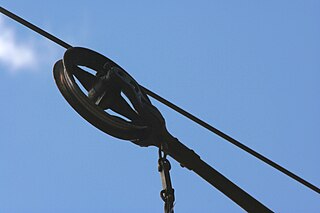
A tram is an urban rail transit in which vehicles, whether individual railcars or multiple-unit trains, run on tramway tracks on urban public streets; some include segments on segregated right-of-way. The tramlines or tram networks operated as public transport are called tramways or simply trams/streetcars. Because of their close similarities, trams are commonly included in the wider term light rail, which also includes systems separated from other traffic.

A trolleybus is an electric bus that draws power from dual overhead wires using spring-loaded trolley poles. Two wires, and two trolley poles, are required to complete the electrical circuit. This differs from a tram or streetcar, which normally uses the track as the return path, needing only one wire and one pole. They are also distinct from other kinds of electric buses, which usually rely on batteries. Power is most commonly supplied as 600-volt direct current, but there are exceptions.

An overhead line or overhead wire is an electrical cable that is used to transmit electrical energy to electric locomotives, electric multiple units, trolleybuses or trams. The generic term used by the International Union of Railways for the technology is overhead line. It is known variously as overhead catenary, overhead contact line (OCL), overhead contact system (OCS), overhead equipment (OHE), overhead line equipment, overhead lines (OHL), overhead wiring (OHW), traction wire, and trolley wire.

A third rail, also known as a live rail, electric rail or conductor rail, is a method of providing electric power to a railway locomotive or train, through a semi-continuous rigid conductor placed alongside or between the rails of a railway track. It is used typically in a mass transit or rapid transit system, which has alignments in its own corridors, fully or almost fully segregated from the outside environment. Third-rail systems are usually supplied from direct current electricity.

The Manx Electric Railway is an electric interurban tramway connecting Douglas, Laxey and Ramsey in the Isle of Man. It connects with the Douglas Bay Horse Tramway at its southern terminus at Derby Castle at the northern end of the promenade in Douglas, and with the Snaefell Mountain Railway at Laxey. Many visitors take an excursion on the trams. It is the oldest electric tram line in the world whose original rolling stock is still in service.

The Snaefell Mountain Railway is an electric mountain railway on the Isle of Man in Europe. It joins the village of Laxey with the summit of Snaefell, at 2,036 feet (621 m) above sea level the highest point on the island. It connects with the Manx Electric Railway (MER) in Laxey. The line is 5 miles (8 km) long, is built to 3 ft 6 in gauge and uses a Fell Incline Railway System centre rail for braking on the steep gradients. It is electrified using overhead wires at 550 volts direct current, with bow collectors.

A trolley pole is a tapered cylindrical pole of wood or metal, used to transfer electricity from a "live" (electrified) overhead wire to the control and the electric traction motors of a tram or trolley bus. It is a type of current collector. The use of overhead wire in a system of current collection is reputed to be the 1880 invention of Frank J. Sprague, but the first working trolley pole was developed and demonstrated by Charles Van Depoele, in autumn 1885.

A pantograph is an apparatus mounted on the roof of an electric train, tram or trolley buses to collect power through contact with an overhead line. The term stems from the resemblance of some styles to the mechanical pantographs used for copying handwriting and drawings.

Conduit current collection is an obsolete system that was used by some electric tramways to pass current to streetcars via a "conduit", a small tunnel under the roadway. Modern systems fall under the term ground-level power supply.

The Great Orme Tramway is a cable-hauled 3 ft 6 in gauge tramway in Llandudno in north Wales. Open seasonally from late March to late October, it takes over 200,000 passengers each year from Llandudno Victoria Station to just below the summit of the Great Orme headland. From 1932 onwards it was known as the Great Orme Railway, reverting to its original name in 1977.

Guided Light Transit was the name of guided bus technology and associated infrastructure manufactured by Bombardier Transportation. Two GLT prototypes were designed and tested from 1987 onwards by BN in the region of Rochefort in Belgium. It was eventully installed in two French cities: Nancy and Caen. The Caen system was closed in 2017 and replaced by conventional trams, while the Nancy system was closed in March 2023 and is to be replaced by trolleybuses.
Tramway track is used on tramways or light rail operations. As with standard rail tracks, tram tracks have two parallel steel rails, the distance between the heads of the rails being the track gauge. When there is no need for pedestrians or road vehicles to traverse the track, conventional flat-bottom rail is used. However, when such traffic exists, such as in urban streets, grooved rails are used.

The Saint-Étienne tramway is a tram system in the city of Saint-Étienne in the Rhône-Alpes (France) that has functioned continuously since its opening in 1881. The first tramway line was steam-operated and was opened by the Chemins de Fer à Voie étroite de Saint-Étienne (CFVE) on 4 December 1881, stretching for 5.5 km between La Terrasse and Bellevue. The CFVE took over the Compagnie des Tramways Électriques de Saint-Étienne lines and discontinued the use of steam in 1912.

The history of trams, streetcars, or trolleys began in the early nineteenth century. It can be divided up into several discrete periods defined by the principal means of motive power used. Eventually the so-called US "street railways" were deemed advantageous auxiliaries of the new elevated and/or tunneled metropolitan steam railways.
The stud contact system is an obsolete ground-level power supply system for electric trams. The studs were cylinders with their tops flush with the road surface, and connected to an electrical cable underground. The studs contained a switch mechanism that made an electrical connection with the top of the stud when a car with a strong magnet at its underside passed over it, before automatically disconnencting. Electrical current was collected from the studs by a "skate" or "ski collector" under the tramcar.

A current collector is a device used in trolleybuses, trams, electric locomotives and EMUs to carry electric power (current) from overhead lines, electric third rails, or ground-level power supplies to the electrical equipment of the vehicles. Those for overhead wires are roof-mounted devices, those for rails are mounted on the bogies.

A rubber-tyred tram is a development of the guided bus in which a vehicle is guided by a fixed rail in the road surface and draws current from overhead electric wires.

Torquay Tramways operated electric street trams in Torquay, Devon, England, from 1907. They were initially powered by the unusual Dolter stud-contact electrification, but in 1911 was converted to more conventional overhead-line supply. The line was extended into neighbouring Paignton in 1911 but the whole network was closed in 1934.

Stalybridge, Hyde, Mossley & Dukinfield Tramways & Electricity Board (SHMD) was a public transport and electricity supply organisation formed by Act of the British Parliament in August 1901. It was a joint venture between the borough councils of Stalybridge, Hyde, Mossley and Dukinfield. The system was officially opened on 21 May 1904.

The Cantono Frigerio system was an Italian electric power supply for trackless trolleybuses with two wires about 20 inches (510 mm) apart being contacted by a four-wheeled collector on a single trolley pole. In English publications it was often described as Filovia system although the Italian term filovia means literally wire way, i.e. a trolleybus line or a trolleybus system.





















